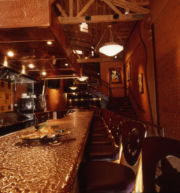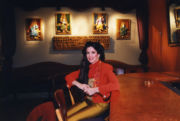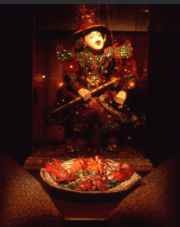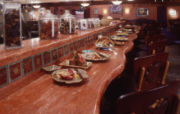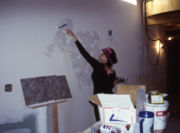Barbara Lazaroff Restaurant Design
The design of ObaChine
![]()
Barbara’s former Beverly Hills restaurant ObaChine, showcased a dazzling blend of Asian styles.
Her unique design of this Asian Restaurant and Satay Bar played off Wolfgang Puck’s fusion cooking from China, Japan, Thailand, Korea, Malaysia, and India.
Barbara celebrated these individual and distinct cultures and accentuated the innovative flavors and presentation of Asian-inspired Wolfgang Puck delicacies.
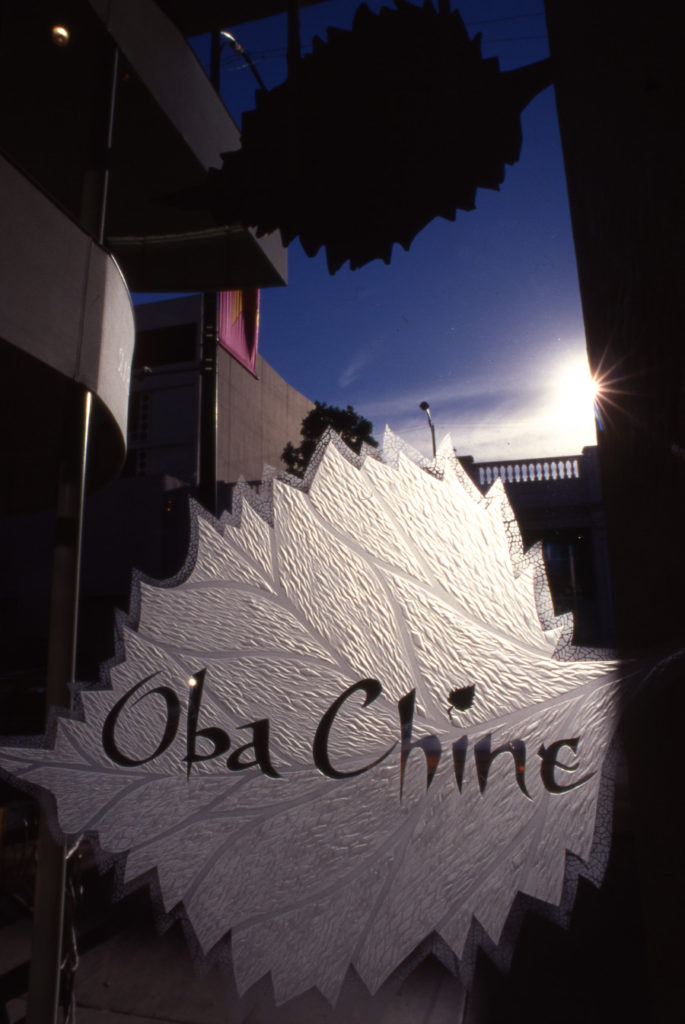 Architecturally, ObaChine featured a loft-like two-level construction, large staircase, and exposed beams. The enormous hammered copper bar snaked its way through the first level alongside sleek booths and massive terracotta painted vents.
Architecturally, ObaChine featured a loft-like two-level construction, large staircase, and exposed beams. The enormous hammered copper bar snaked its way through the first level alongside sleek booths and massive terracotta painted vents.
Lazaroff explained the genesis of the restaurant’s exotic name:
“The reference to the Japanese “Oba” leaf — similar in taste to mint and the French word for China (Chine) evokes a sense of blending of cultures spiritually and aesthetically. I have loved Japanese cuisine for more than 20 years and the Oba or Shiso leaf has always been one of my distinctly favorite flavors. Ultimately, we wanted a name that would simply inspire people’s imagination — ObaChine sounds like a magical land that I’d want to visit.”
Lazaroff’s design of ObaChine was meant to inspire — featuring authentic art brought back from her travels throughout Asia, such as antique Burmese marionettes, beautiful Thai temple stone carvings, a broad variety of Vietnamese paintings and ink drawings and elegant Japanese Obis.
A jewel-toned color scheme rich with aubergine, jade, amber and touches of gold prevail.
The omnipresent symbol of the Oba leaf winds its way onto custom designed hand-carved wood and rattan chairs and exquisite apricot-toned cast glass sconces which adorn the walls producing an alluring glow.
Lazaroff’s dramatic carpet design combines the palette of regal purple, deep apricot and celadon green with mythical forms symbolizing long life, organic elements and the ever-present Oba leaf. The carpet’s flowing waves of graphic design across the expanse of the restaurant pull all of the elements together.
Other interesting design details include artisan rendered, hand-wrought iron railings emulating natural vines ascending to the upper dining room. Sandblasted brick walls, as well as the original wood bow-string trussed ceilings have been exposed to bring a natural warmth into the bar and dining area.
Hand-hewn mahogany stained wood tables are inlaid with etched glass under which you will find reprints of 18th and 19th-century Chinese postcards or Japanese playing cards. These images, as well as reprints of old Japanese book illustrations and artful Asian cuisine photos are imprinted and glazed on ceramic tiles highlighting the kitchen and satay walls. One of the most striking details is the undulating Persian red travertine marble countertops that wrap the exhibition seating counter.
No space has been left untouched by Lazaroff’s creative hand. Even in the restrooms, where Barbara limited her design palette to a serene tone of celadon green, she has invested the space with charm.
One of the elements Lazaroff has created is a series of one of a kind ceramic relief tiles inspired by Japanese calligraphy, which encircle the room.
Puck and Lazaroff also used ObaChine to further extend the thinking behind their trademark exhibition kitchen — first built at Spago and then again at Chinois on Main, Postrio and Granita. Lazaroff had conceived a three-sided performance seating at the main exhibition kitchen and designed an inviting hand-hammered copper “Satay Bar” that allowed customers to interact directly with the chefs as they prepared a wide array of Puck’s Asian-influenced appetizers.
ObaChine is gone now, but you can still appreciate the beauty of Barbara Lazaroff’s again-unique design here.
And some scenes from its construction.



